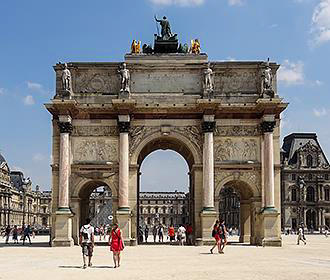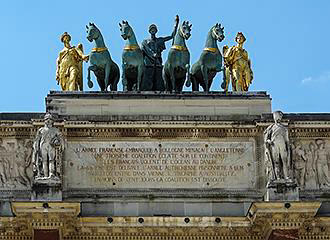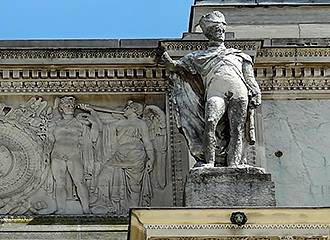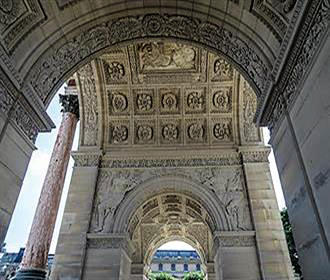Paris Arc de Triomphe du Carrousel in Tuileries Gardens
The Paris Arc de Triomphe du Carrousel is a triumphal arch in Paris that is generally classified as just a smaller version of the most famous Arc de triomphe at the Place de Charles Gaule Etoile by the Champs Elysees.
Now this particular triumphal arch was also commissioned by Napoleon Bonaparte I in order to commemorate his military victories and honour his army and the place chosen was between The Louvre and the Tuileries Gardens, as a gateway to the Tuileries Palace it self.
Situated at the Place du Carrousel inside Tuileries Gardens, when you look at the history of the Louvre, this is where the Tuileries Palace was located prior to its destruction by fire during the Paris Commune and it is on what is known as the historical axes. This historical axes is what links the Louvre Museum with the Tuileries Gardens, the Place de la Concorde up to the larger and more impressive Arc de Triomphe and then on to the Grande Arche in the Defense are of Paris.
The Paris Arc de Triomphe du Carrousel was designed by the French architects Charles Percier and Pierre Francois Leonard Fontaine who were lifelong friends and had previously worked on the Opera Garnier together, and Napoleon Bonaparte I was so impressed with their work, that they became some of his main architects.
This particular triumphal arch was modelled on the triumphal arches of the Roman Empire that characteristically had three arches, with one large arch in the middle flanked each side by two smaller arches and it was named after where it was located and the name refers to a type of military equestrian dressage drill.
About the Paris Arc de Triomphe du Carrousel
Construction of the Paris Arc de Triomphe du Carrousel was started in 1806, which was also when the other Arc de Triomphe Etoile was first started and based on the Constantine Arch, the whole structure is 23 metres wide, just over 7 metres deep and 19 metres high.
The main arch in the middle, was always designed to be reserved for the victor, is just over 6 metres high and the two outside arches are just over 4 metres high and the exterior has eight Corinthian columns topped with statues of soldiers.
Positioned on the top of the Paris Arc de Triomphe de Carrousel were four gilded bronze statues of horses along with a chariot and a statue of Napoleon was supposed to placed within the chariot, but this never happened while he was in power.
Incredibly, the original bronze horses were actually taken by Napoleon as trophies from the St Marks Basilica and square in Venice after one of his victories. The bas reliefs that are depicted on the Paris Arc de Triomphe du Carrousel were chosen by the director of the Napoleon Museum, which, when you look at the history of the Louvre museum, you will see that a section at the Louvre was once called that.
And the bas reliefs on the Paris Arc de Triomphe du Carrousel in Tuileries Gardens depict both military victories and diplomatic victories such as the Battle of Austerlitz and the Treaty of Pressburg, which is now Slovakia, and these were designed by different sculptors such as Jean-Joseph Espercieux.
This triumphal arch was eventually completed in the year 1808, however, after the defeat at the Battle of Waterloo when Napoleon Bonaparte I ended up being imprisoned on the island of St Helena in 1815, the four gilded equestrian statues were returned to Austria. And at this time Austria was annexed to Venice and one of the military leaders from the allies instigated the safe return of these statues to the Saint Marks Cathedral and Square in Venice, which is where they remain today and replicas are on show outside.
Then it was not until 1828 that a new quadriga, which is a chariot drawn by four horses, was sculpted by Baron Francois Joseph Bosio and commemorates the restoration after the fall of Napoleon.
In fact, this incredible sculptor produced many other works that can be seen around Paris such as one in the Chapelle Expiatoire and a statue of King Louis XIV at the Place des Victoires, along with many others that can be found at the Musee du Louvre museum today.
And even though Napoleon saw the inauguration of this Paris monument that he had originally instigated, he never got to see his other triumphal arch completed. And yet, it was the larger Arc de Triomphe that was to be the symbol through which his funeral precession went, on its way to his final resting place at Les Invalides, but when you are on holiday in Paris you have the opportunity of getting to see both of these triumphal arches.
Visiting the Paris Arc de Triomphe du Carrousel
The Paris Arc de Triomphe du Carrousel is located in the 1st Arrondissement of Paris between the Tuileries Gardens and the most famous Paris museum called the Musee du Louvre.
Now the Paris Arc de Triomphe du Carrousel in Tuileries Gardens is situated at the Place du Carrousel with the Jardins du Carrousel on either side, and the nearest Metro stations are the Tuileries stop serving Line 1 and the Palais Royal - Musee du Louvre stop serving Lines 1 and 7. Although, if you are travelling into Paris via the RER trains, then the nearest train station is the Musee d'Orsay stop serving the RER C Line.
However, it is also only a short walk from the River Seine and the Batobus water bus, which has a stop on the right bank close by, plus there are also different buses that will gain you access to this historical Paris landmark including the Paris bus lines 21, 24, 27, 39, 68, 69, 72, 81 and 95 along with the Noctilien Night Bus Service via lines N11 and N24.
And that is in addition to the Balabus that runs on a Sunday and bank holidays, which can also take you to the other Paris monuments and other arches like the modern Grande Arche in the Defense District.



